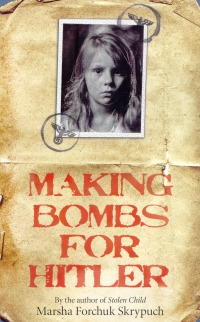| ________________
CM . . . . Volume XVIII Number 26 . . . . March 9, 2012
excerpt:
In 2010, Skrypuch's Stolen Child appeared (See CM, Vol. XVII, No. 1, Sept. 3, 2010). That historical fiction novel told the story of 12-year-old Nadia Kravchuk, who, along with her "parents," Marusia and Ivan, had immigrated to Brantford, ON, from Europe in 1950. All three had been displaced by the events of World War II, and, as the story unfolds, readers discover, along with Nadia, that she has had two other identities: Gretchen Himmel, the daughter of General Himmel who was connected with the Auschwitz concentration camp, and her true identity, Larissa Ferezuk. It was five-year-old Larissa who had been seized by the Germans occupying Ukraine and declared Lebensborn or biologically fit to be "Germanized" by being raised within a German family. However, Larissa's eight-year-old sister, Lida, did not meet that program's criteria, and she was only deemed suitable to be an Ostarbeiter or forced labor worker. It is Lida's story that is the stuff of Making Bombs for Hitler, a book which is not a sequel to Stolen Child. Instead, it should be seen as being a complementary read. Making Bombs for Hitler begins in 1943 with the sisters' separation and concludes in 1951 with their having made mail contact and the anticipation that they will eventually be reunited in Canada. Following the girls' involuntary parting, Lida, along with other forced labor workers, is shipped by cattle car to her Bavarian work camp, arriving on March 14, her ninth birthday. Warned by older girls in her barracks that the Germans don't like younger workers, Lida passes herself off as being 13 during the identification process, a lie which saves her life as those who were under 12 were killed, with some being literally bled to death, their blood providing transfusions for wounded German soldiers. While readers may be aware that Jews in occupied German territories had to wear yellow stars on their clothing, they may not know that the forced labor workers also had to wear identifying OST patches, and to be found without one could mean being shot. Awakened daily at 4:30 am., Lida downed a breakfast consisting of "a triangle of black bread the size of my palm and a tinful of coloured water the cook called tea" while lunch was thin watery turnip "Russian" soup [see excerpt]. Her work day concluded at 6 p.m., and there was no supper, with lights out a 7. Saturdays, Lida and the other labourers finished at noon while Sunday was usually a work-free day. Because of her sewing ability, Lida was initially assigned to the laundry, but, as the title indicates, she was eventually part of a team of slave labourers who were required to assemble bomb components. The war's end brought new dangers to Lida and her fellow Ukrainians whose homelands then fell under Soviet rule. Being sent back home would mean punishment, perhaps even death for Lida, as the Soviets considered her a traitor for having worked for the Nazis, despite the fact that she had no choice. Camps for displaced people then became Lida's home as she tried to fulfill the pledge she had made years before to her little sister: "I will find you. Larissa....I promise." While Lida is the novel's main character, Skrypuch populates Making Bombs for Hitler with many other characters, mostly her fellow slave labourers, including a young man, Luka, who appears to be part of Lida's future. His story, just hinted at in Making Bombs for Hitler, merits its own telling. The conclusion to my review of Stolen Child I will essentially repeat for its complementary tale: Making Bombs for Hitler is a most worthy addition to the body of juvenile literature about the Second World War, and it is a novel that definitely continues to break new ground in terms of its subject matter. Highly Recommended. Dave Jenkinson, CM's editor, lives in Winnipeg, MB.
To comment
on this title or this review, send mail to cm@umanitoba.ca.
Copyright © the Manitoba Library Association. Reproduction for personal
use is permitted only if this copyright notice is maintained. Any
other reproduction is prohibited without permission.
NEXT REVIEW |
TABLE OF CONTENTS FOR THIS ISSUE - March 9, 2012.
AUTHORS |
TITLES |
MEDIA REVIEWS |
PROFILES |
BACK ISSUES |
SEARCH |
CMARCHIVE |
HOME |
